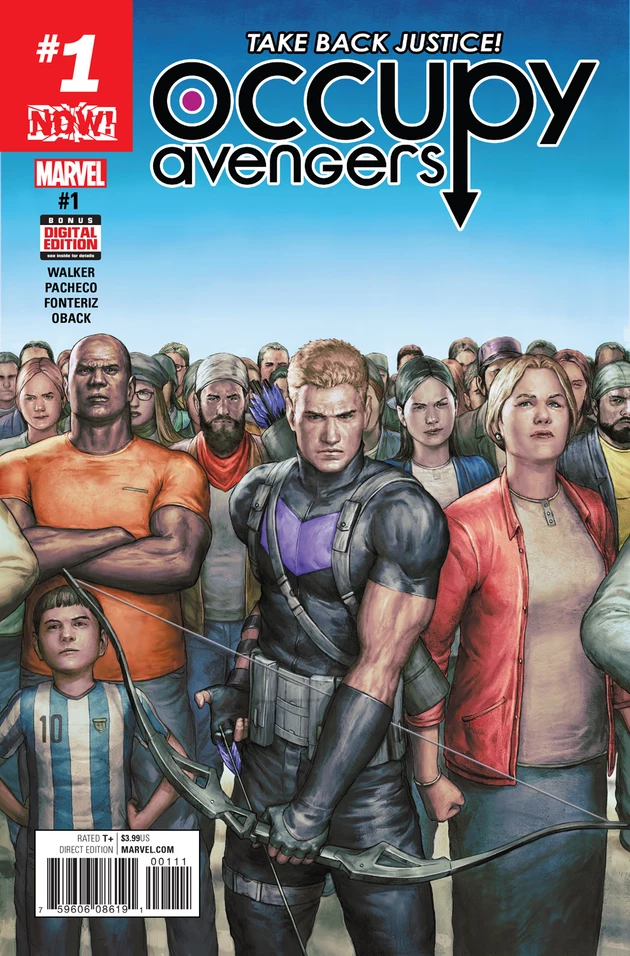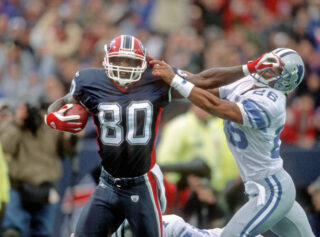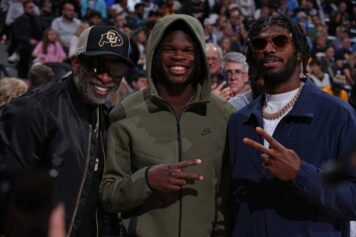Does reality dictate art, or does art inspire our reality?
That is a question that has dogged humanity since the Renaissance era, and we’re no closer to getting an answer than we were centuries ago. These days, the oppression and marginalization of people of color is all over the news. Into this zeitgeist comes Occupy Avengers from Marvel Comics. Written by David Walker, with art from Carlos Pacheco, Rafael Fonteriz, Sonia Oback and Clayton Cowles, Occupy Avengers dropped on November 2.
Looking at the cover for the first time caused me to sneer just a bit. It depicts Avengers regular Hawkeye surrounded by a multi-ethnic crowd of individuals reminiscent of a protest march. I sneered because initially my mind registered the cover art, and the use of the word occupy in the title, as a blatant attempt to profit off the pain of people of color. Then, I remembered David Walker’s prior works and cracked it open. This was definitely art as activism.

The offering begins with Hawkeye taking photos with fans at a desert diner in Santa Rosa, New Mexico. Many of the admirers are singing his praises for being the man who killed the Hulk (Civil War II). Clint Barton’s dialogue is introverted as he goes back and forth about his decision to fire a special gamma radiated arrow provided by Bruce Banner, who directed him to use the arrow should he get the slightest inkling that Banner was about to Hulk out. This is after he was supposedly cured by Amadeus Cho, the new Totally Awesome Hulk.
The live action comic con session is brought to an end when Sheriff Ortiz and her partner Red Wolf arrive and break up all the commotion. The reader soon finds that Barton is in town to investigate the pollution of the town’s previously pristine water. Before the pollution, water from the town aquifer was so desired that much of the town’s revenue came from supplying water to surrounding communities. Now, the people have to resort to importing bottled water to drink and bathe – obviously drawn directly from the environmental terrorism that has occurred in Flint, Michigan.

(Marvel Hip Hop Variant Take on Capone-n-Noreaga by Michael Cho)
Barton advises Sheriff Ortiz that he wants to investigate the water supply, which is at Sweet Medicine reservation outside of town, and see if he is can do anything about the problem. Weary of Barton’s worsening case of white savior syndrome, in part due to the many people he has killed over the years as a government operative, the Sheriff tells Hawkeye that he has to bring Red Wolf with him if he wants to go to the res. The level of poverty that Barton sees causes him to immediately jump into Amnesty International mode, but he was quickly brought back down to earth by Red Wolf and tribal leader Granny Fireheart.

The scene looked like a housing project vomited in the desert. Absolute poverty. Barton, who still doesn’t get it, asks the elder why do people chose to stay in such conditions. He is soon made aware of the economic reality of being poor in America.
If the residents had the money to move, they wouldn’t be poor. Duh! But this type of thinking has been the thought process of many well-intentioned individuals since before activism was called activism.

Soon, Barton is set upon by a group of mercenaries who try to capture him. As a full-fledged Avenger, Hawkeye and his signature bow and arrow have bested better opponents in the past. With assistance from Red Wolf, the mercenaries are easily dispatched. However, what good is a comic book without a villain?
In comes Hydro-Man to soak all hopes of a quick resolution for the heroes. Clearly culled from Flint and Standing Rock travesties perpetrated against the interests people of color, Walker’s take on Hawkeye as a guilt-ridden one-time assassin-turned-hero who just killed a former teammate is realistic. As is the Native American character’s questioning of his intentions.
The significance of race is never mentioned, but a powerless people of color being bamboozled is integral to the storyline. Also, Barton’s white guilt, as well as tribal indifference to his desire to help, are also realities of activism in America. Individuals who come from the same society and ethnic group of oppressors are naturally viewed with suspicion.
Though it’s not yet revealed whether the mercenaries are from a corporate or government agency, it is clear that this action is being undertaken because the people on the reservation are disenfranchised.
Walker’s writing is educational as well as functional. Not only does the dialogue provide insight into the savior-saved paradigm of activism, and Clint’s mindset after killing the Banner. Like many first issues, it piles a lot of information. The penciling is clean and detailed, the coloring is easy on the eyes, soft and bright with a conservative use of heavy shadows. I love the watercolor look of the cover as well. It’s a good read for a first issue and I hope it’s indicative of more great storytelling to come.



